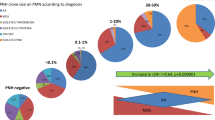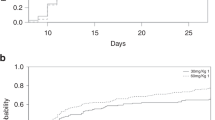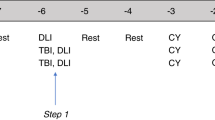Summary:
Paroxysmal nocturnal haemoglobinuria (PNH) is an acquired clonal disorder of haematopoietic stem cells associated with a somatic mutation in the phosphatidylinositol glycan complementation class A (PIG-A) gene. The only curative option is an allogeneic stem cell transplant (SCT), although treatment is hazardous. A 46-year-old male patient with PNH and obvious signs of severe, progressive haemolysis was transplanted in July 2002 with highly purified CD34 T-cell depleted peripheral blood stem cells from his HLA-identical brother. Prior to transplantation, the PNH was resistant to immunosuppressive therapy. The patient received 6.1 × 106/kg bodyweight CD34-positive cells with a proportion of CD3-positive cells of 0.81 × 104/kg bodyweight. After engraftment, 12 days post transplant (neutrophils>1.0/nl) the patient's physical condition steadily improved and parameters of haemolysis decreased. No glycophosphatidylinositol-deficient cells in peripheral blood could be detected by flow cytometry 40 and 100 days after transplant. We conclude that PNH may be cured by allogeneic CD34-enriched SCT from a sibling donor attempting to avoid acute GVHD and to reduce cumulative organ toxicity by using this transplantation modality.
This is a preview of subscription content, access via your institution
Access options
Subscribe to this journal
Receive 12 print issues and online access
$259.00 per year
only $21.58 per issue
Buy this article
- Purchase on SpringerLink
- Instant access to full article PDF
Prices may be subject to local taxes which are calculated during checkout

Similar content being viewed by others
References
Rosse WF, Ware RE . The molecular basis of paroxysmal nocturnal hemoglobinuria. Blood 1995; 86: 3277–3286.
Takahashi M, Takeda J, Hirose S et al. Deficient biosynthesis of N-acetylglucosaminyl-phosphatidylinositol, the first intermediate of glycosyl phosphatidylinositol anchor biosynthesis, in cell lines established from patients with paroxysmal nocturnal hemoglobinuria. J Exp Med 1993; 177: 517–521.
Ware RE, Hall SE, Rosse WF . Paroxysmal nocturnal hemoglobinuria with onset in childhood and adolescence. N Engl J Med 1991; 325: 991–996.
Hillmen P, Lewis SM, Bessler M et al. Natural history of paroxysmal nocturnal hemoglobinuria. N Engl J Med 1995; 333: 1253–1258.
Socie G, Mary JY, de-Gramont A et al. Paroxysmal nocturnal hemoglobinuria: long-term follow-up and prognostic factors. Lancet 1996; 31: 573–577.
Tooze JA, Marsh JC, Gordon-Smith EC . Clonal evolution of aplastic anaemia to myelodysplasia/ acute myeloid leukaemia and paroxysmal nocturnal haemoglobinuria. Leuk Lymphoma 1999; 33: 231–241.
Richards SJ, Rawstron AC, Hillmen P . Application of flow cytometry to the diagnosis of paroxysmal nocturnal haemoglobinuria. Cytometry 2000; 42: 223–233.
Socie G . Recent advances in paroxysmal nocturnal haemoglobinuria: from the biology to the clinic. Hematol Cell Ther 1997; 39: 175–187.
Beelen DW, Peceny R, Elmaagacli AH et al. Transplantation of highly purified HLA-identical sibling donor peripheral blood CD34+ cells without prophylactic post-transplant immunosuppression in adult patients with first chronic phase of chronic myeloid leukaemia: results of a phase II study. Bone Marrow Transplant 2000; 26: 823–829.
Elmaagacli AH, Peceny R, Steckel N et al. Outcome of transplantation of highly purified peripheral blood CD34+ cells with T cell add-back compared to unmanipulated bone marrow or peripheral blood stem cells from HLA-identical sibling donors in patients with first chronic phase chronic myeloid leukemia. Blood 2003; 101: 446–453.
Bemba M, Guardiola P, Garderet L et al. Bone marrow transplantation for paroxysmal nocturnal haemoglobinuria. Br J Haematol 1999; 105: 366–368.
Raiola AM, Van Lint MT, Lamparelli T et al. Bone marrow transplantation for paroxysmal nocturnal hemoglobinuria. Haematologica 2000; 85: 59–62.
Iwamaoto N, Kawaguchi T, Horikawa K et al. Preferential hematopoiesis by paroxysmal nocturnal hemoglobinuria clone engrafted in SCID mice. Blood 1996; 87: 4944–4948.
Nishimura J, Murakami Y, Kinoshita T . Paroxysmal nocturnal hemoglobinuria: an acquired genetic disease. Am J Hematol 1999; 62: 175–182.
Author information
Authors and Affiliations
Corresponding author
Rights and permissions
About this article
Cite this article
Ditschkowski, M., Trenschel, R., Kummer, G. et al. Allogeneic CD34-enriched peripheral blood stem cell transplantation in a patient with paroxysmal nocturnal haemoglobinuria. Bone Marrow Transplant 32, 633–635 (2003). https://doi.org/10.1038/sj.bmt.1704206
Received:
Accepted:
Published:
Issue date:
DOI: https://doi.org/10.1038/sj.bmt.1704206



